Cellulite remains one of the most misunderstood and frustrating cosmetic concerns, especially for women. Despite being a completely normal and non-threatening skin condition, cellulite is often stigmatized due to unrealistic beauty standards perpetuated by media and advertising. This widespread pressure to achieve flawless skin has driven the popularity of aesthetic procedures designed to reduce its appearance. A simple online search for “cellulite before and after” images reveals an entire world of cosmetic treatments—complete with dramatic visuals, glowing testimonials, and an overwhelming array of options. Yet many people are left wondering: do these procedures truly work, and what do those cellulite treatment before and after results really reflect?
This article delves into the real-world effectiveness of three of the most talked-about treatment modalities for cellulite—laser therapy, radiofrequency energy, and microneedling. By evaluating the science behind each intervention and interpreting what before and after cellulite pictures actually reveal, we offer a balanced, evidence-based perspective to guide those seeking smoother legs and greater skin confidence.
You may also like: How to Tighten Loose Skin After Weight Loss: Science-Backed Strategies for a Firmer, Healthier You

The Science Behind Cellulite: What Are We Really Treating?
Understanding what causes cellulite is key to evaluating the validity of any treatment. Scientifically, cellulite is not a result of poor hygiene, laziness, or even obesity—despite persistent myths suggesting otherwise. Instead, it’s a structural skin issue that affects nearly 90 percent of post-pubertal women. Cellulite occurs when subcutaneous fat deposits push through fibrous connective tissue beneath the skin, leading to the dimpled, uneven texture commonly seen on the thighs, buttocks, and hips.
The reason cellulite is more prevalent in women than men lies in basic anatomical differences. Female skin has vertically oriented collagen septae that allow fat to protrude more easily, whereas male connective tissue forms a crisscrossed pattern that better contains underlying fat cells. Hormonal factors, especially estrogen, also play a critical role by influencing fat storage, skin elasticity, and circulation. Genetics, aging, and lifestyle factors such as physical inactivity or poor lymphatic drainage can exacerbate these structural weaknesses.
With this in mind, effective cellulite treatments must target more than just surface-level concerns. The best outcomes often result from therapies that address the deep dermal layers and subdermal structures while simultaneously improving skin texture and tone. Thus, understanding the physiological nature of cellulite helps contextualize the true meaning behind before and after cellulite photos.
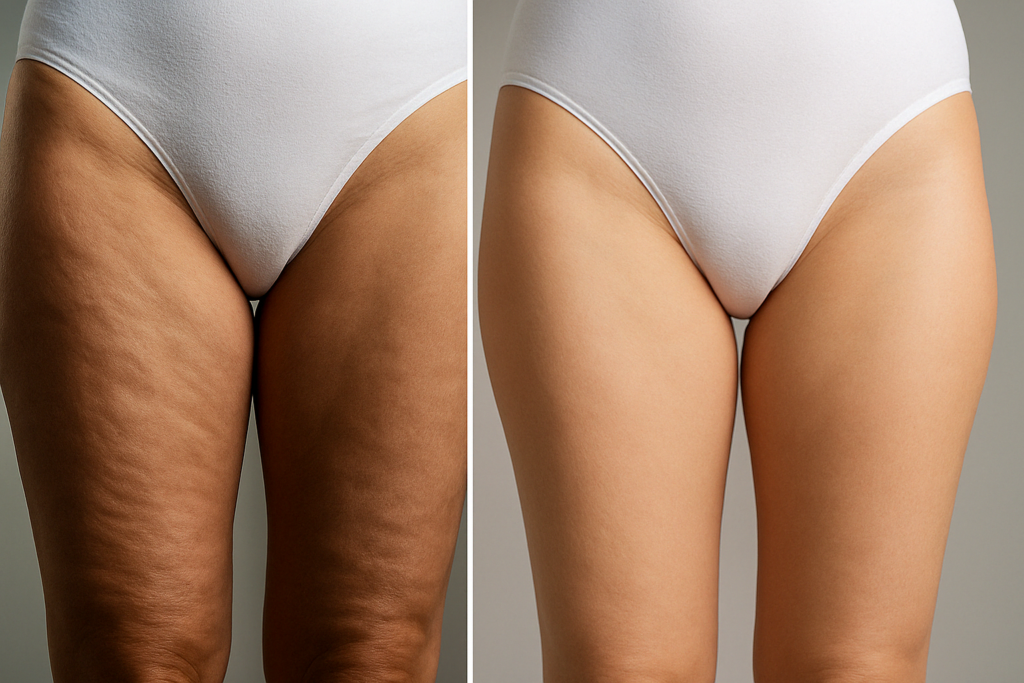
Interpreting Cellulite Before and After Photos: What Can We Really Learn?
Before and after cellulite pictures serve as powerful visual testimonials, but they often obscure more than they reveal. Lighting, camera angles, skin hydration, and even posture can dramatically alter the appearance of cellulite in photos. For example, shadows in poorly lit images tend to exaggerate skin dimpling, while soft, diffuse lighting can conceal it. Moreover, subtle differences in muscle tension—such as whether the subject is flexing or relaxed—may distort outcomes. In clinical photography, rigorous standardization is essential for accurate comparisons, but most consumer-focused photos rarely follow such protocols.
Even when taken in good faith, cellulite before and after photos cannot speak to long-term results. Temporary improvements due to swelling, increased circulation, or local inflammation post-treatment may falsely suggest more permanent change. That said, professional before and after cellulite photos—especially those from board-certified dermatologists and aesthetic practitioners—can still be valuable when presented transparently. These images offer insight into the realistic, incremental progress many patients achieve with consistent and appropriately chosen treatment plans.
Ultimately, the most informative before and after cellulite pics are those accompanied by clinical context, including treatment details, patient demographics, number of sessions, and duration of follow-up. Without this, even the most impressive transformation photo offers limited utility in understanding actual outcomes. As we explore each treatment modality, we will also examine what these photos tend to reflect—and what they often leave out.
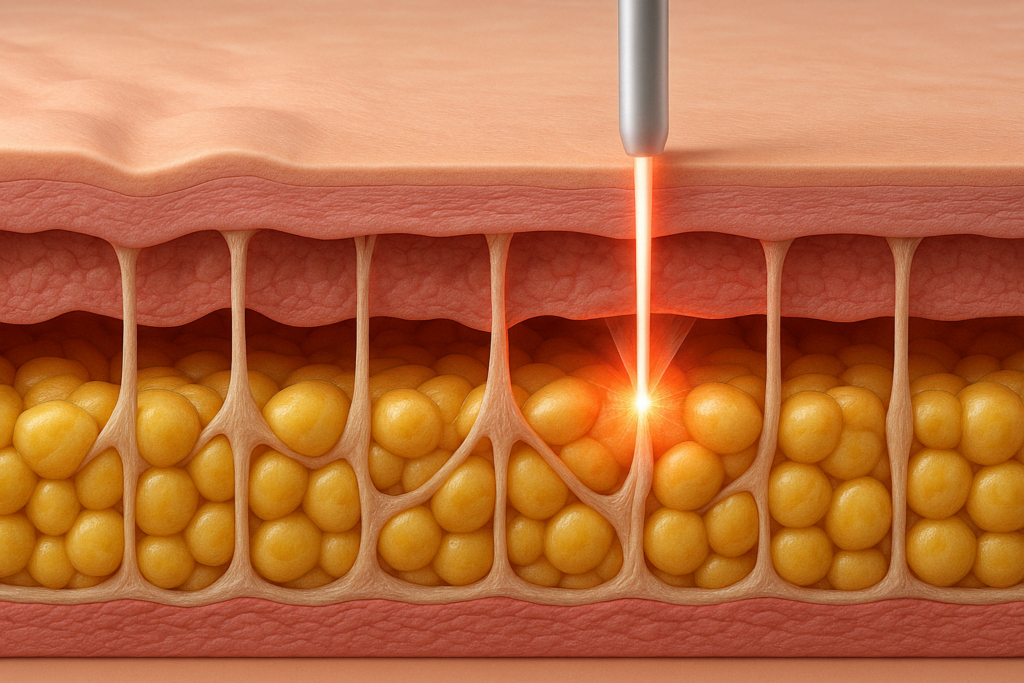
Laser Treatment for Cellulite Before and After: Targeting the Root Structure
Laser therapy is one of the most extensively studied options for cellulite reduction. Among the various devices available, minimally invasive laser treatments such as Cellulaze are designed to sever the fibrous septae beneath the skin while promoting collagen remodeling. This dual action addresses the structural causes of cellulite, leading to smoother, firmer skin over time. When evaluating laser treatment for cellulite before and after images, what becomes evident is a more consistent texture and less visible dimpling.
These outcomes are not immediate. In fact, patients often report seeing the most significant changes several weeks or months after the procedure as collagen synthesis continues. Additionally, laser treatments are often combined with suction or mechanical massage to enhance lymphatic drainage and improve results. While some before and after cellulite pictures show dramatic improvement, others depict more subtle changes—highlighting the role of individual factors such as skin thickness, age, and baseline severity.
Laser therapy does carry some risks, including bruising, swelling, and temporary tenderness, though these are generally mild and short-lived. Importantly, not all patients are ideal candidates. Those with very loose skin or severe fat deposition may require adjunct procedures for optimal outcomes. Still, for the right candidate, laser therapy can produce durable, meaningful changes—as evidenced by an increasing number of satisfied patients sharing their cellulite before and after photos across reputable dermatology forums and medical journals.
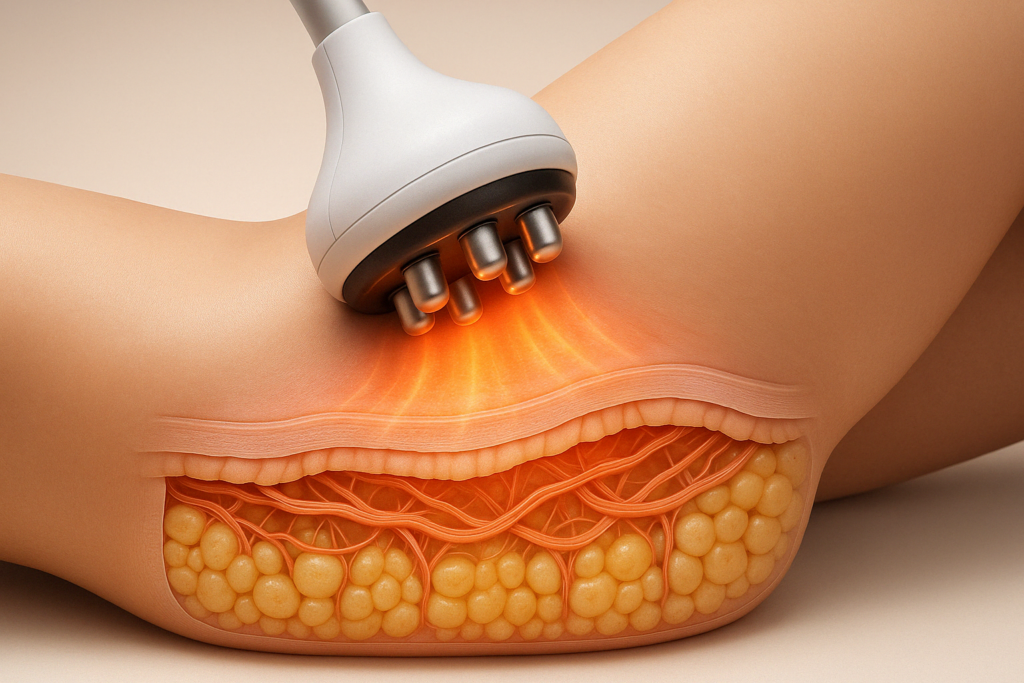
Radiofrequency for Cellulite Before and After: Remodeling Without Invasion
Unlike laser therapies that may require small incisions, radiofrequency (RF) treatments offer a non-invasive alternative that also targets the underlying causes of cellulite. Devices such as Venus Legacy and Thermage use controlled RF energy to heat the dermis and subcutaneous tissues, promoting collagen contraction, neocollagenesis, and improved circulation. These biological effects lead to a firmer, more even skin appearance over time.
Patients often turn to radiofrequency for cellulite before and after comparisons that showcase noticeable improvements in skin texture without the downtime associated with more invasive procedures. Because RF treatments are typically delivered in a series of sessions, gradual enhancement is expected, and subtle cumulative effects often translate to a smoother surface over several weeks. The most reliable before and after cellulite photos for RF therapy usually reflect consistent lighting, stable positioning, and longitudinal progress tracking, allowing observers to gauge real efficacy.
However, not all results are permanent. Maintenance treatments may be necessary to preserve collagen integrity and prolong benefits, especially in older patients or those with poor skin elasticity. Radiofrequency’s appeal lies in its versatility and safety profile, making it suitable for a wide range of skin types and tones. Still, individual variability must be considered, as some patients respond better than others based on genetic predisposition, lifestyle, and treatment consistency.
Ultimately, radiofrequency treatments continue to earn positive attention in both clinical literature and aesthetic practice due to their favorable risk-benefit ratio. With realistic expectations, patients can use before and after cellulite photos to track progress and identify gradual improvements that may not be immediately visible in daily life.
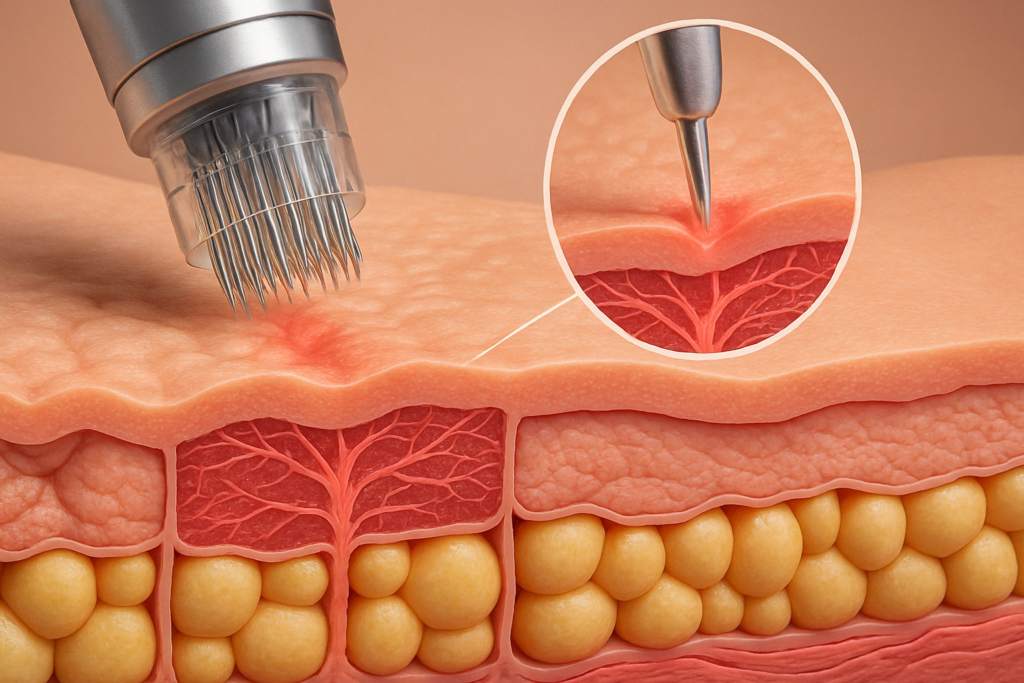
Microneedling for Cellulite: Can Collagen Induction Improve Texture?
Among the most intriguing options in modern aesthetic medicine is microneedling—a procedure long hailed for its ability to reduce acne scars and fine lines, now gaining traction for cellulite management. When specifically applied to the legs, cellulite microneedling before and after images often reveal enhanced smoothness and improved skin texture, especially in mild to moderate cases. This treatment works by creating controlled micro-injuries that stimulate the body’s wound-healing response, triggering new collagen and elastin production.
For cellulite, microneedling can be performed alone or in conjunction with topical agents like hyaluronic acid, retinol, or even radiofrequency. Some advanced techniques use longer needles to reach deeper dermal layers, offering more substantial results for leg cellulite. The visible effects in cellulite before and after pics may include improved skin firmness and a more uniform surface, particularly in areas with minimal fat protrusion.
It’s essential to recognize that microneedling outcomes require patience and multiple sessions. Changes tend to be gradual, with optimal results appearing after several months. Moreover, the integrity of before and after cellulite pictures in this context depends heavily on photographic accuracy. Lighting, angle, and timing can exaggerate or downplay changes, so clinical standards are critical for honest representation.
Despite its minimally invasive nature, microneedling is not entirely risk-free. Temporary redness, swelling, and sensitivity are common, and infection is possible without proper technique. Yet when administered by trained professionals and complemented by medical-grade skincare, microneedling can become a valuable component of a comprehensive cellulite management strategy. As more patients share their cellulite microneedling legs before and after experiences, the body of evidence supporting its use continues to grow.
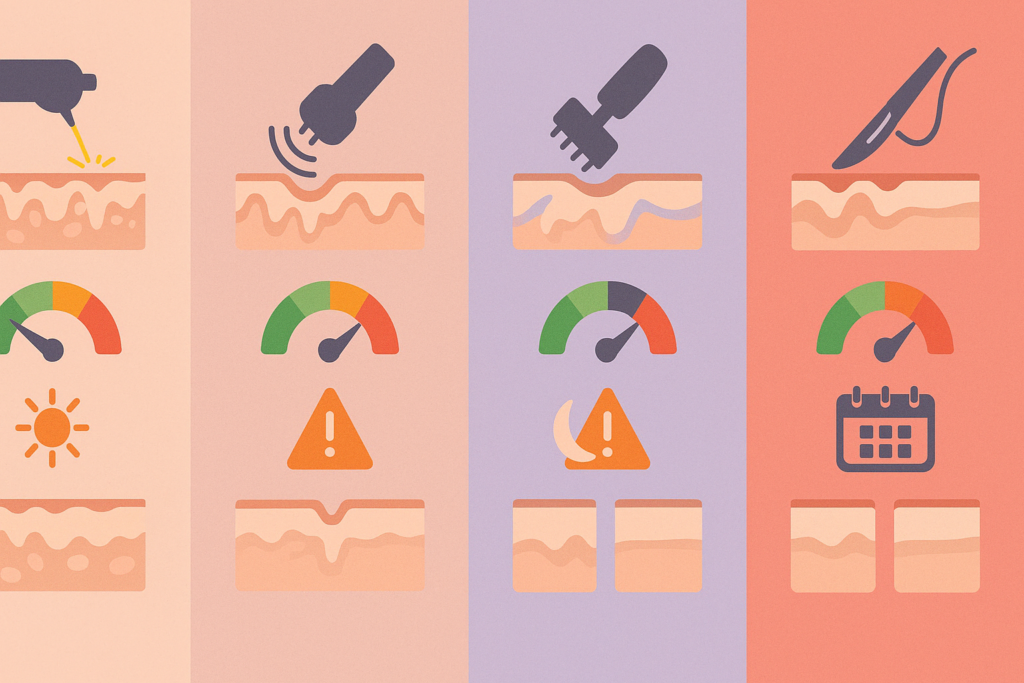
Why Cellulite Surgery Before and After Results Require Caution
For individuals seeking more dramatic results, surgical interventions such as subcision or liposuction are sometimes considered. However, the term “cellulite surgery before and after” can be misleading without proper explanation. While these procedures can reduce fat volume or release tethered bands beneath the skin, they do not always target the underlying architectural issues that contribute to cellulite. In fact, liposuction alone may worsen skin dimpling if not paired with skin tightening measures.
Subcision, on the other hand, is a more targeted surgical approach that involves breaking up the fibrous septae responsible for cellulite formation. It is often combined with laser or radiofrequency devices to enhance collagen production and further improve skin tone. Still, the efficacy of cellulite surgery before and after results varies widely depending on the technique, practitioner skill, and individual patient anatomy.
Another concern involves the recovery process. Surgical treatments for cellulite require longer downtime, and risks such as scarring, pigmentation changes, or asymmetry are more pronounced. Therefore, it’s crucial that patients approach before and after cellulite photos from surgical procedures with skepticism, especially when the source lacks transparency or exaggerates claims.
Expert cosmetic dermatologists emphasize that surgery should be a last resort, reserved for those with significant skin laxity or resistant cellulite. When used judiciously and supported by adjunctive non-invasive therapies, surgical treatments can offer meaningful improvement. Nevertheless, the decision to undergo such procedures should be grounded in realistic expectations and a clear understanding of risks versus benefits.
Psychological Impact of Cellulite and the Role of Realistic Expectations
While physical treatments can improve the skin’s appearance, it’s equally important to address the psychological burden associated with cellulite. Many individuals—especially women—report feelings of shame, embarrassment, or reduced self-confidence due to visible cellulite. Social media and advertising have only intensified these feelings by presenting unrealistic and heavily edited beauty standards.
The repeated exposure to flawless “after” images can create a skewed perception of what is possible, often leading to disappointment when real-life results do not match the idealized portrayals. This is why it’s essential for providers and patients alike to view before and after cellulite photos as tools for education and expectation setting, not as promises of perfection.
Integrating a body-positive perspective with aesthetic treatments offers a more holistic approach to cellulite management. Celebrating progress rather than perfection and emphasizing skin health over appearance can foster emotional well-being. Furthermore, engaging with practitioners who prioritize transparency, safety, and long-term care over quick fixes contributes to more satisfying and sustainable results.
Frequently Asked Questions: Expert-Level Insights on Cellulite Treatment Before and After Results
1. Why do some people see minimal change in their cellulite before and after photos despite undergoing professional treatments?
While many patients expect dramatic transformations, some experience only subtle changes in their cellulite before and after photos due to individual biological variability. Factors such as collagen density, skin thickness, and even circulatory health can significantly influence outcomes. Additionally, the timeline of improvement can span several months, and results are often cumulative rather than instantaneous. In some cases, insufficient treatment frequency or improper post-procedure care—such as skipping hydration protocols or wearing tight clothing—can hinder progress. For the most accurate reflection of change, before and after cellulite pictures should be taken under standardized conditions and at consistent intervals.
2. Are the results shown in laser treatment for cellulite before and after images sustainable long term?
Laser treatment for cellulite before and after photos often show promising results, but long-term maintenance varies depending on lifestyle factors and skin aging. Collagen regeneration stimulated by laser therapy continues for months, but skin elasticity gradually declines with age, which may diminish the longevity of results. Weight fluctuations, dehydration, and lack of exercise can also impact the durability of the smoother appearance. Some dermatologists recommend booster treatments every 12 to 18 months to preserve gains. Ultimately, while laser treatments can structurally improve skin texture, ongoing self-care is essential to maintaining visible benefits over time.
3. How does the lighting and skin preparation affect cellulite before and after pics?
Lighting plays a deceptively powerful role in the visual interpretation of cellulite before and after pics. Soft, diffused lighting can smooth over imperfections, whereas harsh or directional lighting emphasizes skin texture and shadows. Beyond light manipulation, temporary changes such as topical products, bronzers, or even mild swelling can falsely exaggerate improvements in cellulite before and after photos. To obtain an authentic comparison, skin should be free of moisturizers or stimulants before photography, and natural daylight or consistent clinical lighting should be used. Dermatology clinics often adhere to these standards to enhance the credibility of their image documentation.
4. Is there a difference in treatment outcomes between cellulite on legs before and after compared to other body areas?
Yes, cellulite on legs before and after results may differ significantly from other regions like the buttocks or abdomen due to anatomical and structural factors. The thighs typically have thinner skin and more noticeable fat lobules pressing against connective tissue, making cellulite more prominent. These features can both aid and limit treatment efficacy depending on the chosen modality. For instance, cellulite microneedling legs before and after images may show more textural improvement due to enhanced dermal collagen remodeling, while laser-based treatments might be more effective on denser areas like the glutes. Personalizing treatment by body zone increases the likelihood of achieving optimal results.
5. How does microneedling compare with surgery in terms of cellulite before and after outcomes?
While cellulite microneedling legs before and after images often show gradual, natural-looking improvement, cellulite surgery before and after results can offer more immediate, albeit riskier, changes. Microneedling stimulates collagen formation over time and is best suited for mild to moderate cases, especially in patients with good skin elasticity. In contrast, cellulite surgery involves physically cutting fibrous bands beneath the skin and may be better for severe dimpling or thicker connective tissue. However, surgery comes with downtime, higher costs, and the possibility of scarring. Many dermatologists now recommend combining microneedling with other modalities to amplify results while minimizing invasiveness.
6. What are some emerging innovations influencing cellulite treatment before and after outcomes?
Emerging technologies such as acoustic wave therapy, injectable enzymes, and bio-stimulatory fillers are reshaping the landscape of cellulite treatment before and after possibilities. These approaches aim to address different components of cellulite—such as improving circulation, breaking down fibrous septae, and volumizing depressed areas. For example, combining radiofrequency for cellulite before and after procedures with topical peptides may enhance skin repair mechanisms. Likewise, new laser platforms with multi-wavelength capabilities are being tested to simultaneously tighten skin and reduce subcutaneous fat. These innovations are still undergoing clinical trials but may soon provide more comprehensive and nuanced solutions.
7. Can stress or hormonal imbalances affect the results seen in cellulite before and after photos?
Chronic stress and hormonal dysregulation can absolutely influence the appearance and persistence of cellulite. Elevated cortisol levels from stress can impair collagen production and promote fat storage, both of which compromise treatment outcomes. Moreover, estrogen plays a significant role in fluid retention and fat distribution, meaning that hormonal shifts during menopause or menstrual cycles may alter the skin’s responsiveness to therapy. As a result, some patients notice temporary regression in their cellulite before and after photos during times of hormonal fluctuation. Holistic management, including endocrine health and mental well-being, can enhance and sustain aesthetic results.
8. What psychological effects can result from viewing dramatic before and after cellulite photos online?
Exposure to idealized or heavily edited cellulite before and after photos can negatively affect body image and self-esteem, especially in individuals already struggling with skin insecurity. The contrast between professional post-treatment images and one’s own progress may foster unrealistic expectations or dissatisfaction. In some cases, this can lead to compulsive treatment-seeking behavior or overreliance on cosmetic interventions. Mental health professionals and aesthetic providers alike are increasingly advocating for transparency in image presentation and encouraging clients to measure success based on personal progress rather than comparison. Viewing cellulite as a common physiological phenomenon rather than a flaw helps counteract the psychological impact of digitally altered visuals.
9. What role do compression garments play in post-treatment cellulite before and after results?
Compression garments are often recommended following procedures like laser therapy or cellulite surgery to optimize recovery and enhance results. These garments aid lymphatic drainage, reduce swelling, and help the skin conform more smoothly to its new contours. Wearing them consistently may also prevent fluid retention and secondary inflammation, which could otherwise obscure the visual benefits seen in before and after cellulite pictures. While they do not directly eliminate cellulite, their supportive function improves treatment visibility in cellulite before and after photos. Patients who comply with compression protocols often experience more refined and lasting improvements.
10. How do ethnicity and skin tone influence cellulite treatment before and after results?
Skin tone and ethnicity can subtly affect how cellulite treatment before and after results manifest, particularly in how skin responds to heat, inflammation, and pigmentation shifts. Individuals with darker skin types may be more prone to post-inflammatory hyperpigmentation after aggressive treatments like subcision or ablative laser. For this reason, practitioners often tailor protocols, using gentler settings or alternate devices such as radiofrequency for cellulite before and after outcomes that are both safe and effective. Additionally, differences in dermal thickness and collagen content across ethnic groups may impact how visible dimpling appears pre- and post-treatment. Cultural perceptions of beauty also play a role in how results are evaluated and appreciated.
Conclusion: What Cellulite Before and After Photos Can—and Cannot—Tell You
For those navigating the often overwhelming world of cosmetic treatments, cellulite before and after photos can serve as both inspiration and guidance. Yet these images must be interpreted with discernment. Whether evaluating laser treatment for cellulite before and after results, assessing the efficacy of radiofrequency for cellulite before and after improvements, or exploring the gradual transformations captured in cellulite microneedling legs before and after photos, it’s essential to look beyond the surface.
The most compelling cellulite before and after photos are not the ones that promise perfection, but those that reflect real, incremental progress supported by science, expertise, and patient commitment. Equally important is the context in which these images are shared. Without transparency regarding treatment type, duration, and individual characteristics, even the most dramatic before and after cellulite pictures can mislead.
Ultimately, the journey toward smoother legs is a personal one. Whether through non-invasive methods like radiofrequency and microneedling, or more intensive interventions such as laser therapies and subcision, each path carries its own considerations. Trustworthy, medically sound information paired with realistic expectations can help patients choose the right strategy for their unique needs. As aesthetic medicine continues to evolve, so too should our understanding of what true transformation looks like—both in cellulite treatment before and after results and in our evolving relationship with our bodies.
Was this article helpful? Don’t let it stop with you. Share it right now with someone who needs to see it—whether it’s a friend, a colleague, or your whole network. And if staying ahead on this topic matters to you, subscribe to this publication for the most up-to-date information. You’ll get the latest insights delivered straight to you—no searching, no missing out
Further Reading:
Top 10 Cellulite Treatments That Work: The Ultimate Guide
Cellulite treatments: What really works?
VelaShape Cellulite Treatment Before and After Photos
Disclaimer
The information contained in this article is provided for general informational purposes only and is not intended to serve as medical, legal, or professional advice. While Health11News strives to present accurate, up-to-date, and reliable content, no warranty or guarantee, expressed or implied, is made regarding the completeness, accuracy, or adequacy of the information provided. Readers are strongly advised to seek the guidance of a qualified healthcare provider or other relevant professionals before acting on any information contained in this article. Health11News, its authors, editors, and contributors expressly disclaim any liability for any damages, losses, or consequences arising directly or indirectly from the use, interpretation, or reliance on any information presented herein. The views and opinions expressed in this article are those of the author(s) and do not necessarily reflect the official policies or positions of Health11News.